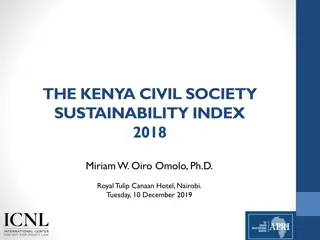
Contemporary Economic Policy Issues at Osher Lifelong Learning Institute
Dive into contemporary economic policy issues at the Osher Lifelong Learning Institute hosted by Duke University. Explore topics like US economy, healthcare economics, climate change, and more. Engage with expert speakers and gain valuable insights into pressing economic challenges. Join this enriching educational experience to enhance your understanding of crucial economic matters.
Download Presentation

Please find below an Image/Link to download the presentation.
The content on the website is provided AS IS for your information and personal use only. It may not be sold, licensed, or shared on other websites without obtaining consent from the author. If you encounter any issues during the download, it is possible that the publisher has removed the file from their server.
You are allowed to download the files provided on this website for personal or commercial use, subject to the condition that they are used lawfully. All files are the property of their respective owners.
The content on the website is provided AS IS for your information and personal use only. It may not be sold, licensed, or shared on other websites without obtaining consent from the author.
E N D
Presentation Transcript
Osher Lifelong Learning Institute, Spring 2023 Contemporary Economic Policy Issues Duke University May-June, 2023 Host: Jon Haveman, Ph.D. National Economic Education Delegation 1
Available NEED Topics Include: US Economy Immigration Economics Healthcare Economics Housing Policy Climate Change Federal Budgets Economic Inequality Federal Debt Economic Mobility Black-White Wealth Gap Trade and Globalization Autonomous Vehicles Minimum Wages Healthcare Economics 2
Course Outline Contemporary Economic Policy - Week 1 (5/2): US Economic Update (Geoffrey Woglom, Amherst College) - Week 2 (5/9): Monetary Policy (Geoffrey Woglom) - Week 3 (5/16): Healthcare Economics (Kelley Cullen, E. Washington University) - Week 4 (5/23): Climate Change Economics (Sarah Jacobson, Williams College) - Week 5 (5/30): The Black-White Wealth Gap (Mike Shor, Univ. of Connecticut) - Week 6 (6/6): Federal Debt (Jon Haveman, NEED) 3
Submitting Questions Please submit questions of clarification in the chat. - I will try to handle them as they come up. We will do a verbal Q&A once the material has been presented. Slides will be available from the NEED website soon. (https://needelegation.org/delivered_presentations.php) 4
Health(care) Economics Duke University May 16, 2023 Kelley Cullen, Ph.D. Eastern Washington Univ. 5
Kelley L. Cullen PhD, Economics Washington State University
Outline What is Health(care) Economics? Taking the Pulse of the Health Economy Health Care Systems and Institutions Health Insurance and Reform Pharmaceuticals Big Pharma
What is Health(care) Economics? Health Economics is a field of MICROeconomics that focuses on the health care industry. Examples of other subfields of microeconomics include: - labor economics, industrial organization, economics of education, public economics, and urban economics.
Health Economics is part of Microeconomics Although health economics is part of micro- economics, it is actually very big: - In 2019, U.S. national health expenditure were 17.7% of GDP, which is equivalent to around $3.8 trillion. For comparison, GDP in each country in 2019: - Germany: $3,845 trillion (4th largest economy) - UK: $2,827 trillion (6th largest economy) - France : $2,715 trillion (7th largest economy)
Where the money goes? Source: Centers for Medicare & Medicaid Services, Office of the Actuary, National Health Statistics Group.
What is Health Economics? Health economics studies health care resource markets and health insurance. Healthcare is the biggest industry and the largest employer in the US.
What is a Market? A market is a group of buyers and sellers of a particular product in the area or region under consideration. The area may be the earth, or countries, regions, states, or cities. The concept of a market is any structure that allows buyers and sellers to exchange any type of goods, services, and information. Markets can be physical and non-physical. There are many different types of markets and depending on the type, different rules should be set up for achieve the best results for society.
Markets Studied in Health Economics Markets for: - Physicians - Nurses - Hospital facilities - Nursing homes - Pharmaceuticals - Medical supplies (such as diagnostic and therapeutic equipment) - Health Insurance
Pulse of the Health Economy Health economy involves activities related to population health: - Production and consumption of goods and services. - Distribution of those goods to consumers. Performance indicators of medical care: - Access - Quality - Cost
Access 16
Health Insurance Coverage, 2019 Percent of Persons 17 Source: National Center for Health Statistics
Health Insurance Coverage By Age, 2019 Percent of Persons 18 Source: National Center for Health Statistics
Health Insurance Coverage by Income, 2019 Percent of Persons 19 Source: National Center for Health Statistics
Health Insurance Coverage by Race, 2019 Percent of Persons 20 Source: National Center for Health Statistics
Physician Visits and Physician Supply Average physician visits per capita, 2017 Practicing physicians per 1,000 population, 2018 9.9 8.3 OECD average: 6.8 7.7 4.8 6.8 4.3 4.3 4.1 OECD average: 3.5 6.1 3.7 3.6 3.3 3.2 4.5 4.3 2.9 2.7 4.0 2.6 3.8 2.8 SWE NZ US SWIZ NOR FRA CAN AUS NETH GER NOR SWIZ GER SWE AUS NETH NZ FRA UK CAN US 21 Source: Roosa Tikkanen and Melinda K. Abrams, U.S. Health Care from a Global Perspective, 2019: Higher Spending, Worse Outcomes (Commonwealth Fund, Jan. 2020).
Avoidable Deaths 2000 2016 Deaths per 100,000 population. Heart disease, stroke, hypertension 149 145 135 131 121 117 112 111 109 108 90 90 86 84 82 72 67 65 62 60 60 54 SWIZ FRA NOR AUS SWE NETH CAN NZ UK GER US 22 Source: Roosa Tikkanen and Melinda K. Abrams, U.S. Health Care from a Global Perspective, 2019: Higher Spending, Worse Outcomes (Commonwealth Fund, Jan. 2020).
Waited Less Than a Month to See A Specialist But how much time did they spend with the specialist? 100 92 88 How often was it necessary to see a specialist? 81 80 79 Percent of Women Ages 18-64 80 68 67 63 59 60 52 47 40 20 0 SWIZ US NETH UK GER NZ FR SWE AUS CAN NOR 23 Source: 2011 Commonwealth Fund International Health Policy Survey of Sicker Adults in Eleven Countries.
Hospital Acute Care Average Length of Stay Average length of stay for acute care (days) 7.5 7.4 OECD average: 6.4 6.0 5.9 5.6 5.5 5.5 5.5 5.0 4.9 4.2 AUS NZ NETH SWE SWIZ US FRA UK NOR CAN GER 24
Acute Care Hospital Beds per 1,000 Population 9 7.9 8 7 6 5.3 5 4 3.4 3.4 3.3 2.9 2.9 3 2.6 2.5 2.5 2.3 2.3 1.9 2 1.7 1 0 JAP GER AUS FR NETH SWIZ OECD median NZ DEN US NOR UK SWE CAN 25 Source: OECD Health Data 2015.
Percent of Women Ages 1864 Who Reported Having A Regular Doctor/Regular Place of Care 100 99 99 99 97 95 94 94 94 89 88 US SWIZ UK SWE AUS CAN NZ GER NOR FRA NETH 26 Source: Munira Z. Gunja et al., What Is the Status of Women s Health and Health Care in the U.S. Compared to Ten Other Countries? (Commonwealth Fund, Dec. 2018).
Percent of Women Ages 1864 Who Reported Going to the Emergency Room in the Past Two Years 45 37 37 32 29 28 24 24 21 21 12 GER UK NETH AUS NZ NOR SWIZ FRA SWE US CAN 27 Source: Munira Z. Gunja et al., What Is the Status of Women s Health and Health Care in the U.S. Compared to Ten Other Countries? (Commonwealth Fund, Dec. 2018).
Access Notes Insurance coverage in the U.S. is not universal. Supply of medical personnel and equipment may be lower than elsewhere. Avoidable (amenable) deaths are higher, perhaps indicating less access to care. Emergency room use is higher in the U.S. than elsewhere. Specialized medicine is more accessible. 28
Quality 29
A Bit About Quality The U.S. has the highest chronic disease burden - and an obesity rate that is two times higher than the OECD average. Americans had fewer physician visits than peers in most countries - which may be related to a low supply of physicians in the U.S. The U.S. has among the highest # of hospitalizations from preventable causes - and the highest rate of avoidable deaths. Americans use some expensive technologies - MRIs, and specialized procedures, such as hip replacements, more often than our peers. The U.S. outperforms its peers in terms of preventive measures - One of the highest rates of breast cancer screening among women ages 50 to 69. - Second-highest rate (after the U.K.) of flu vaccinations among people age 65 and older.
Life Expectancy: How Does the US Compare? 84 SWIZ: 83.6 82 Everybody else NOR: 82.7 FRA: 82.6 80 AUS: 82.6 SWE: 82.5 78 CAN: 82.0 NZ: 81.9 76 NETH: 81.8 74 UK: 81.3 United States GER: 81.1 72 US: 78.6 70 1980 1985 1990 1995 2000 2005 2010 2015 Germany US = 2.5 years 31 Source: Roosa Tikkanen and Melinda K. Abrams, U.S. Health Care from a Global Perspective, 2019: Higher Spending, Worse Outcomes (Commonwealth Fund, Jan. 2020).
Life Expectancy & Per Capita GDP Life expectancy in years 85 JPN FIN CAN ESP ISL LUX ISR ITA AUS CHE FRA NOR KOR SWE IRL NLD NZL GRC AUT DNK PRT GBR 80 SVN DEU CRI CHL BEL CZE USA TUR POL EST SVK CHN HUN MEX 75 BRA COL LVA LTU RUS 70 IDN IND R = 0.57 65 0 20000 40000 60000 80000 100000 GDP per capita (USD PPP) 32
Life Expectancy at Birth by Race, 2017 Race/Ethnicity All Races White Black Hispanic Life Expectancy (Years) 78.6 78.8 75.3 81.8
Infant Mortality International Comparison Deaths per 1,000 live births 5.80 4.70 4.20 3.90 3.80 3.50 3.30 3.20 3.10 2.30 2.00 SWE NOR AUS GER SWIZ NETH FRA UK NZ CAN US 36 Source: NEED from OECD Data
Maternal Mortality Rate 38 Source: Roosa Tikkanen et al., Maternal Mortality and Maternity Care in the United States Compared to 10 Other Developed Countries (Commonwealth Fund, Nov. 2020). https://doi.org/10.26099/411v-9255
Percent of adults who have experienced medical, medication, or lab errors or delays 19.0 20 17.0 18 15.0 16 14.0 14 11.0 11.0 12 10.0 10 8.0 7.0 8 6 4 2 0 US SWE CAN SWIZ UK AUS NETH FR GER 40 Source: 2016 Commonwealth Fund International Health Policy Survey.
Prevention and Screening The U.S. excels in some prevention measures, including flu vaccinations and breast cancer screenings. The U.S. has the highest average five-year survival rate for breast cancer, but the Lowest for Cervical Cancer.
Flu Immunization Percent of adults age 65 and older immunized (%). 73 68 65 64 61 OECD average: 44% 50 49 35 34 UK US NZ NETH CAN FRA SWE GER NOR Source: Roosa Tikkanen and Melinda K. Abrams, U.S. Health Care from a Global Perspective, 2019: Higher Spending, Worse Outcomes (Commonwealth Fund, Jan. 2020).
Breast Cancer Screening Percent of females ages 50 69 screened (%). 90 80 78 76 75 72 OECD average: 60% 55 54 51 50 49 SWE US NETH NOR UK NZ AUS CAN GER FRA SWIZ Source: Roosa Tikkanen and Melinda K. Abrams, U.S. Health Care from a Global Perspective, 2019: Higher Spending, Worse Outcomes (Commonwealth Fund, Jan. 2020).
Suicides, 2016 Deaths per 100,000 population 13.9 13.1 OECD average: 11.5 11.6 11.9 11.5 11.8 11.2 11.1 10.5 10.2 7.3 UK GER NETH SWE SWIZ NZ NOR CAN AUS FRA US 44 Source: Roosa Tikkanen and Melinda K. Abrams, U.S. Health Care from a Global Perspective, 2019: Higher Spending, Worse Outcomes (Commonwealth Fund, Jan. 2020).
Obesity Rate, 2017 Percent (%) 40.0 32.2 30.4 28.7 26.3 OECD average: 21% 23.6 17.0 13.4 13.1 12.0 11.3 SWIZ NOR SWE NETH FRA GER CAN UK AUS NZ US 45 Source: Roosa Tikkanen and Melinda K. Abrams, U.S. Health Care from a Global Perspective, 2019: Higher Spending, Worse Outcomes (Commonwealth Fund, Jan. 2020).
Adults with Multiple Chronic Conditions, 2016 Percent (%) 28 22 11-country average: 17.5% 18 18 17 16 16 15 15 14 14 NETH UK AUS SWIZ NOR NZ GER FRA SWE CAN US 46 Source: Roosa Tikkanen and Melinda K. Abrams, U.S. Health Care from a Global Perspective, 2019: Higher Spending, Worse Outcomes (Commonwealth Fund, Jan. 2020).
The World Health Report 2000, Health Systems: Improving Performance Overall Ranking Overall Ranking 30. 1. Canada France 31. 2. Finland Italy 32. 3. Australia San Marino 33. 4. Chile Andorra 34. 5. Denmark Malta 35. 6. Dominica Singapore 36. 7. Costa Rica Spain 37. 8. United States Oman 38. 9. Slovenia Austria 39. 10. Cuba Japan
Perception of Quality of Medical Care Percent of women ages 18 64 who rated their quality of medical care as excellent or very good. 62 61 59 55 54 51 49 47 39 33 24 US SWE CAN NZ GER NOR NETH FRA AUS SWIZ UK 48 Source: Munira Z. Gunja et al., What Is the Status of Women s Health and Health Care in the U.S. Compared to Ten Other Countries? (Commonwealth Fund, Dec. 2018).
Quality of Care Notes Metrics of quality in the U.S. are not very good. Quality of care is not considered very good in the U.S. The system has challenges: obesity/lifestyle. The system has bright spots! 49
Costs 50






















